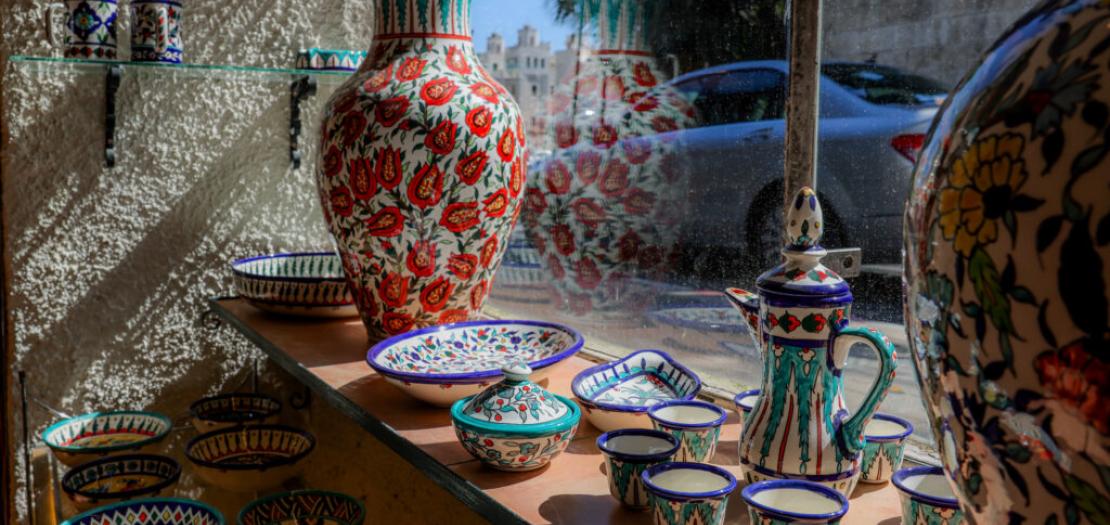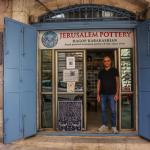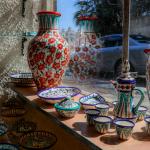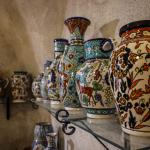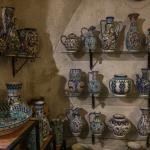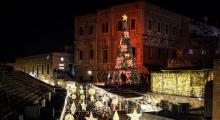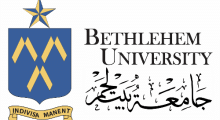Issued by the Catholic Center for Studies and Media - Jordan. Editor-in-chief Fr. Rif'at Bader - موقع أبونا abouna.org
Balian Ceramics is a tranquil space on Nablus Road, one of the busy thoroughfares in occupied East Jerusalem. A group is taking a pottery class to the sound of a running fountain, tiled with glistening elaborate ceramic patterns, while surrounded by intricate handmade mugs, crockery and murals.
From ancient biblical imagery to Islamic geometry, the ceramic patterns carry the diverse history of the civilizations that have passed through Jerusalem. The Balian workshop is run by fourth-generation Armenians and serves as a stronghold of the oldest diaspora community in Jerusalem.
But their story actually begins in Yorkshire.
In 1913, British diplomat Marc Sykes hired Armenian ceramic artist David Ohanessian to design a “Turkish Room” in his English stately home. The room was adorned with Iznik-style tiles from Ohanessian’s hometown in Kutahya – a center for the Ottoman ceramic industry.
In 1919, through Sykes, Ohanessian was asked to restore the tiles on the neglected Dome of the Rock. Commissioned by the British Mandate’s Military Governor Sir Ronald Storrs, Ohanessian headed for Jerusalem, bringing with him two Armenian craftsmen: potter Neshan Balian Sr. and artist Megerditch Karakashian.
The restoration of the mosque was ultimately cancelled, allegedly due in part to funding and some protests from the Muslim community about the Christian craftsmen. But the potters and their families decided to stay.
Thus, a new tradition was born – a distinct and elaborate craft that “exists nowhere else”, says Setrag Balian, the great-grandson of Neshan Balian Sr.
“It’s rarely purely ‘Armenian’ ceramics of Jerusalem; it’s inspired by a lot of different arts and cultures,” Setrag says, going on to explain the artistic influences – from Persian animals to the ancient bird motif dedicated to Armenian soldiers, and the Palestinian tree of life. Some motifs begin where another ends, interconnected and woven together: there is a poetry to it all.
“The mix of all these different art forms and styles is what gives you Armenian ceramics of Jerusalem. The art is really a testament or an incarnation of that Armenian diaspora.”
In 1922, Balian and Karakashian decided to part ways with Ohanessian and established Palestinian Pottery on 14 Nablus Road in East Jerusalem. Working under a strict division of labor, the Balians were in charge of pottery and glazes, while the Karakashians handled drawing, designs and painting.
In 1964, the two families amicably parted ways and each set up their own workshops. Hagop is the third generation to run the Karakashians shop of today in the Old City. It’s quiet in the shop this afternoon – he’s also been hit hard by the lack of tourists returning to the ancient city.
“When I was six years old, my father used to take me with him to the studio. I used to sit next to him dangling my feet on the chair,” Hagop says.
He explains that one of the first solo commissions for the Karakashian family was the street signs of the Old City. Unveiled in 1966 during the Jordanian rule, the signs are in Arabic and English and made with tiles. Taking me outside with him, Hagop points to the signs: the tiles in Hebrew above the original ones were added after the 1967 war when Jerusalem came under Israeli control.
Both Hagop and Setrag show me the ancient pots made by their ancestors. The signatures on the pots also bear the markers of the city’s various occupiers, ranging from “Palestine” to “Jordan”. Now, the craftsmen just sign their work with “Jerusalem”.
“If you look even at the history of our pottery, it’s also to a certain extent the history of Jerusalem,” says Hagop.
The split between the families allowed Setrag Balian’s grandmother, Marie Balian, to draw and design ceramics, skills she’d learnt from studying fine arts in Lyon.
“All the murals you see in the corridor are my grandmother’s work,” he says proudly. “You can almost hear the birds singing, the water whooshing, and the gazelles prancing. She brought movement and life to the art form and completely revolutionized it,” he says, adding that she had exhibitions across the world.
On the facade of homes and buildings like the famous American Colony Hotel or Rockefeller Museum, the ceramics have become colorful adornments that accent the city.
Much of the art can be seen in the Armenian Quarter, which comprises the southwestern corner of the Old City. But the community’s population has dwindled from around 27,000 a century ago to less than 2,000 today. Traditionally members of the Orthodox Church, the Armenians are part of the wider diminishing number of Christians in Jerusalem – now less than 2 per cent of the city’s population.
As one of the first nations to accept Christianity in 301 AD, there has been a presence of Armenians in the Holy Land since the fourth century when monks settled in what is now the Armenian quarter of the Old City.
When the 1915 Armenian Genocide unfolded, Jerusalem also became a refuge.
Hagop describes a more vibrant Armenian community of the past.
“When I walk through the quarter now, it’s a bit sad because I remember how lively it was, full of people,” Hagop says.
He describes a life that is becoming more difficult for Armenians in Jerusalem. They basically have the same legal rights as Palestinians. He mentions a 2022 incident when IDF soldiers allegedly spat at the Armenian archbishop and other pilgrims.
“We are a minority here, officially you have the freedom to worship, be in your religion, but underneath there is a tension. "
He explains that the events of October 7th have worsened the situation and divisions.
“When you hear the sirens, you know, it’s frightening. Your knees go weak. And there’s always this tension, specifically in Jerusalem,” says Hagop.
The most recent threat to the community is a controversial real estate deal. An agreement made by the Armenian Patriarchate has resulted in 25 per cent of the Quarter being leased to a Jewish-Australian businessman for a luxury development.
In 2021, the community’s spiritual leadership and also the area’s primary landowner, Nourhan Manougian, signed a lease with the firm Xana Gardens for the area known as the “Cows’ Garden”.
Reportedly the plot covers 11,500 square meters with room for expansion and includes a large car park, some of the church buildings, and the homes of five Armenian families.
“I’m angry because there’s no transparency. We don’t even know what the agreement is. Did they really sell? Did they really sign?” says Hagop.
While the Armenian Patriarch admitted to signing away the land, he claimed he was deceived by a local priest, Baret Yeretsian, who has since fled to California. In the Armenian-American press, Baret Yeretsian has dismissed the idea that the buyer of the land lease is driven by any form of ideology.
But locals believe the deal could be part of a wider settler movement encroaching on the Old City.
“We are under threat,” Hagop says. “Israeli policy aims to take as much land inside the Old City as possible.”
Xana Gardens have not commented on this publicly.
“It’s prime real estate inside the Old City. It’s been in Armenian hands for many centuries. Why should we sell it or think about selling it?” says Hagop.
“This land was entrusted to the community 500 years ago. It’s crucial that we maintain a presence,” says Setrag, referring to ancient deeds that stipulate the land should be passed down through the community.
In October 2023, the Patriarchate formally announced a cancellation of the deal. Tensions heightened, though, when machinery arrived to start demolition, triggering clashes at the Cows’ Garden in November between locals, the business owner and settlers.
Reports suggest $300,000 will be charged to the developer for the lease; hence Setrag believes it’s part of a “settler industry”.
He explains by comparing the area to being like Piccadilly Circus or Oxford Street in London: “It’s the most disputed and also the most expensive,” Setrag says, infuriated by the strangely low fee involved in the deal.
With the threat to his people’s land, Setrag now splits his time between ceramics and activism. Joined by close friend Hagop Djernazian, he is spearheading the local movement “Save the ArQ”.
The two young men wander around the site to point to places where there have been flashes of violence, recalling how they’ve seen off attacks by armed settlers and masked vandals.
As part of a defence, a homemade barricade has been formed, comprising barbed wire, flags and discarded furniture that now lines the car park. Behind it, the activists have erected a large cross.
A group of older men sit at the table in the den-like structure next to the barricade. Some even spend the night there, supported by volunteers from the local community.
For many, Cows’ Garden is a symbol of the dwindling community that must be held on to. They fear that its loss – a large part of the Armenian quarter – would be an existential threat to the community.
“We continue to maintain a presence on the ground but now the legal battle is [what is] more important,” says Hagop Djernazian, explaining how the Armenian Church and the community have begun proceedings through the Israeli courts to challenge the validity of the contract.
On their social media, Save the ArQ say “we have been threatened, attacked, and encroached upon, yet our determination keeps on increasing with each passing day”.
Setrag is fueled by this determination. This case has become a symbol for the preservation of the Christian Armenians in Jerusalem – much like the ceramic tradition. At the end of most work days, he locks up the ceramics shop and heads over to the Cows’ Garden site.
Although Setrag says there are ups and downs to running a family business, both places are crucial to him.
“It’s very important to continue, especially after all the sacrifices that were made to keep this business going for so long. You can’t imagine the Balian family without ceramics,” Setrag replies, when asked if he would ever leave.
Hagop Karakashian expresses a similar sentiment, looking out on the empty street in the Old City.
“My father passed the torch onto me.”
“Back then, I didn’t realize the responsibility on my shoulders, but now I am proud to continue and preserve this tradition,” Hagop says, noting that his daughter is currently learning the craft.
As the Armenian community faces continued threats, the pottery workshops are a beacon of their enduring legacy – one that carries the unique history and culture of Jerusalem through the generations.



